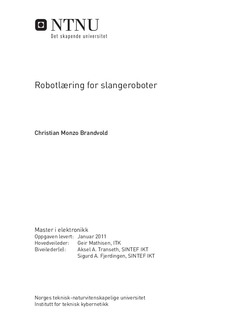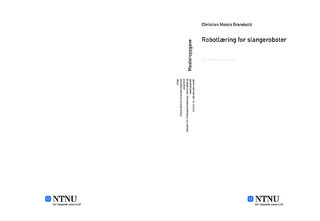| dc.description.abstract | Robots shaped as snakes snake robots have a vast potential within areas such as seach and rescue, and inspection and maintenance. Snake robots with active wheels are a specialized form of snake robots. The active wheels are advantageous in made-made environments such as office floors, factories and ventilation systems. The active wheels and the articulated body of the robots offer an efficient platform for moving both horizontally and vertically. A snake robot needs to be able to perform advanced motions in order to navigate complex man- made environments such as pipe-structures. The topic of this master s thesis is to develop control strategies for snake robot motions on flat planes and in pipe structures. A previously developed simulator for simulation of wheeled snake robot locomotion with a snake robot called Piko [1] will be available. Suggested work 1. Get acquainted with the simulator and make a short tutorial how to, e.g.: install the simulator for development, read sensor signals, control the various degrees of freedom, and perform simulations without visualization. 2. Develop and implement necessary improvements of the simulator. 3. Perform a short literature study within the following topics relevant to the thesis: a. Reinforcement learning b. Function approximators for reinforcement learning c. Current pipe inspection robots and their capabilities (degree of autonomy, design, etc) 4. Formulate one or more motion primitives (controllers) and investigate how to optimize control strategies based on the motion primitives by the use of robot learning. a. In particular, investigate by using the simulator a motion primitive which endows a wheeled snake robot with the capability to lift its head as high as possible. Notes - The robot learning strategies may be based on results from [2]. - If another type of learning framework than reinforcement learning is employed (e.g. evolutionary algorithms), the literature study should reflect this. 1. Fjerdingen, S.A., Liljebäck, P. and Transeth, A.A., A snake-like robot for internal inspection of complex pipe structures (PIKo), in Proc. IEEE/RSJ Int. Conf. on Intelligent Robots and Systems , St. Louis, USA, Oct 11-15, 2009, pp. 5665-5671. 2. Fjerdingen, S.A., Kyrkjebø, E., Transeth, A.A., AUV Pipeline Following using Reinforcement Learning, in Proc. Int. Symp. on Robotics , München, Germany, June 8-11, 2010, to appear. | nb_NO |

